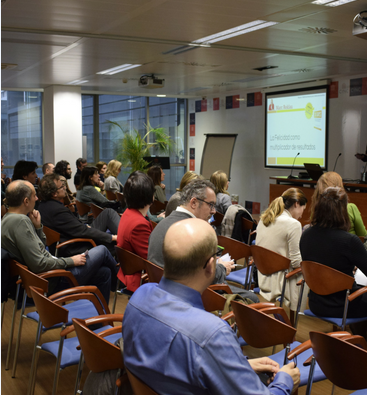1. Detrás de los verbos modales, excepto ought y used, que rigen infinitivo con to:
You may leave now Puedes irte ahora
That can wait Eso puede esperar
You must do it Debes hacerlo
2. Con los verbos de percepción, como to hear (oír), to see (ver) y to feel (sentir) (v. tamb. 13.12):
I saw him leave Lo vi marcharse
They heard him swear Lo oyeron blasfemar
We felt the earth tremble Sentimos la tierra temblar
pero en pasiva se usa infinitivo con to:
He was seen to enter Lo vieron entrar
He was heard to swear Lo oyeron blasfemar The earth was felt to tremble Se sintió temblar la tierra
3. Con los siguientes verbos y expresiones: to make, to let, had better (usualmente abreviado a ’d better), would rather (generalmente abreviado a 'd rather), would sooner, need hardly y cannot but:
He made her cry La hizo llorar
Let it go ¡Suéltalo!
You’d better stop Mejor será que pares
I’d rather stay at home Prefiero quedarme en casa I’d sooner die than betray her Antes morir que traicionarla I need hardly tell you that No necesito decirte que
you must be careful debes tener cuidado
I cannot but complain about No puedo sino quejarme de your odd behaviour tu extraño comportamiento
En pasiva, to make toma infinitivo con to:
She was made to cry La hicieron llorar You will be made to work hard Te harán trabajar duro
To let no debe usarse en pasiva, debiendo ser sustituido por to be allowed/permitted:
They won’t let you do it • You won’t be allowed/permitted to do it (no te dejarán hacerlo)
They didn’t let him • He wasn’t allowed/permitted to enter the disco enter the disco
(no le permitieron entrar en la discoteca)
Con ’d rather son posibles dos construcciones:
a) l'dlhe'dlwe'd, etc., rather+ infinitivo sin to, cuando el sujeto de ’d rather y el del infinitivo es el mismo:
I’d rather drive Prefiero conducir yo
Would you rather walk ¿Prefieres caminar
or take the bus? o coger el autobús?
b) I'd, etc., rather + simple past, cuando el sujeto de ’d rather y el del simple past son diferentes:
I’d rather you didn’t Prefiero que no
smoke in my car fumes en mi coche
She’d rather we arrived earlier Prefiere que lleguemos más temprano
Nota, 'd rather se usa sólo para indicar que alguien prefiere hacer algo en un momento determinado; para preferencias permanentes se usa to prefer:
I’d rather walk Prefiero caminar (ahora)
I prefer walking to taking the bus Prefiero caminar a coger el autobús
(siempre)
4. Con el verbo to help (ayudar) el uso oscila: unas veces rige infinitivo sin to, y otras con to:
I helped him (to) cut the grass Le ayudé a cortar el césped
5. En preguntas que empiezan por why (¿por qué?) o why not (¿por qué no?):
Why wait for them? ¿Por qué esperarlos?
Why not begin now? ¿Por qué no empezar ahora?
6. En ciertas preguntas que indican sorpresa o duda ante lo dicho por nuestro interlocutor:
Help them? Never in my life! ¿Ayudarles yo? ¡Nunca en la vida! Nicole marry you? ¿Casarse contigo Nicole?
Don’t flatter yourself! ¡Note hagas ilusiones!
7. En las llamadas pseudo-cleft sentences o wh-cleft sentences, construcción similar a las cleft sentences (v. 6.14.4), que se usa frecuentemente en conversación para destacar, dándole posición final (end-focus position), aquello que se realizó o va a realizarse. En este caso son posibles generalmente tanto el infinitivo con to, como sin to:
What you’ve done is (to) Lo que has hecho es spoil everything estropearlo todo
What I’m going to do is (to) Lo que voy a hacer es have a bath darme un baño
All I did was (to) drink Todo lo que hice fue beber a couple of beers un par de cervezas
(pero generalmente sin to cuando el infinitivo va en posición inicial: Drink a couple of beers was all I did)
8. En respuestas a preguntas, usando sólo el infinitivo y ningún otro verbo:
«What shall we do if he doesn’t «¿Qué haremos si no come?» «Begin without him» viene?» «Empezar sin él»
En todos los demás casos se usa el infinitivo con to. No obstante, resumimos a continuación (v. 13.5) las construcciones más frecuentes con este último.








